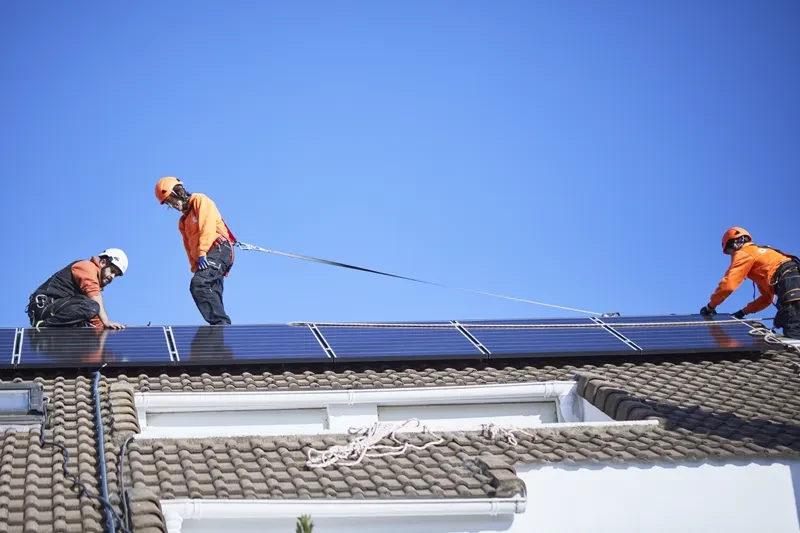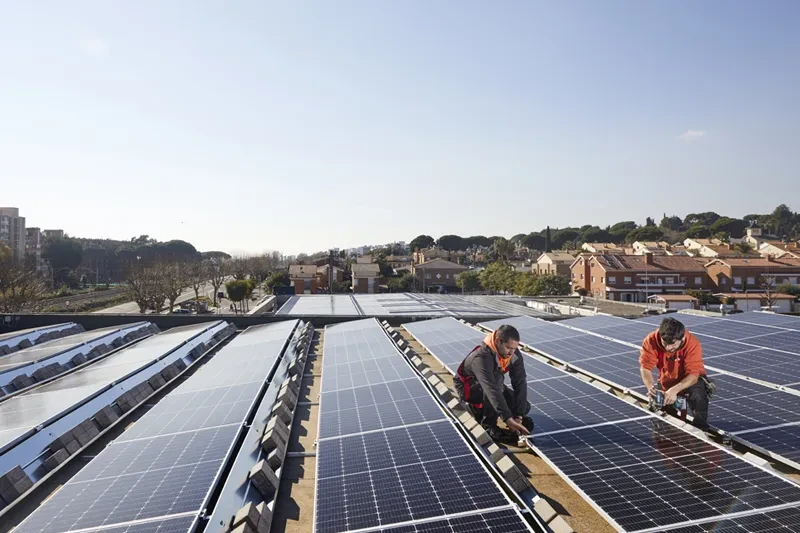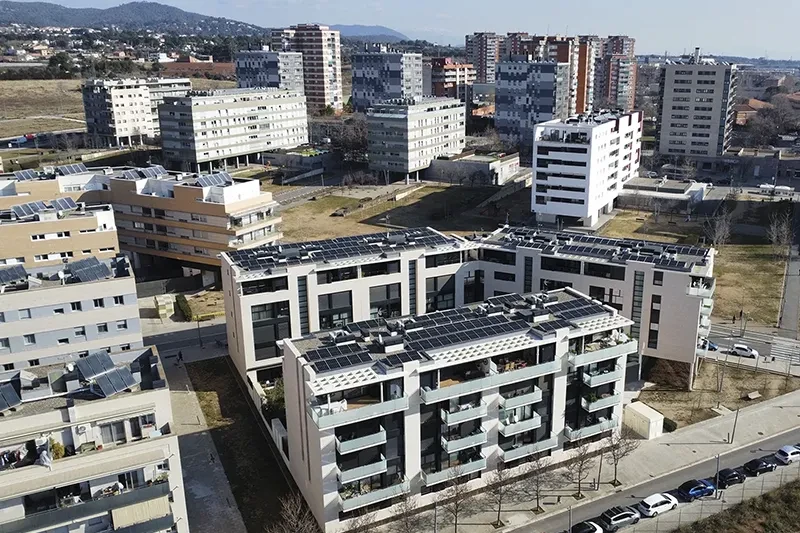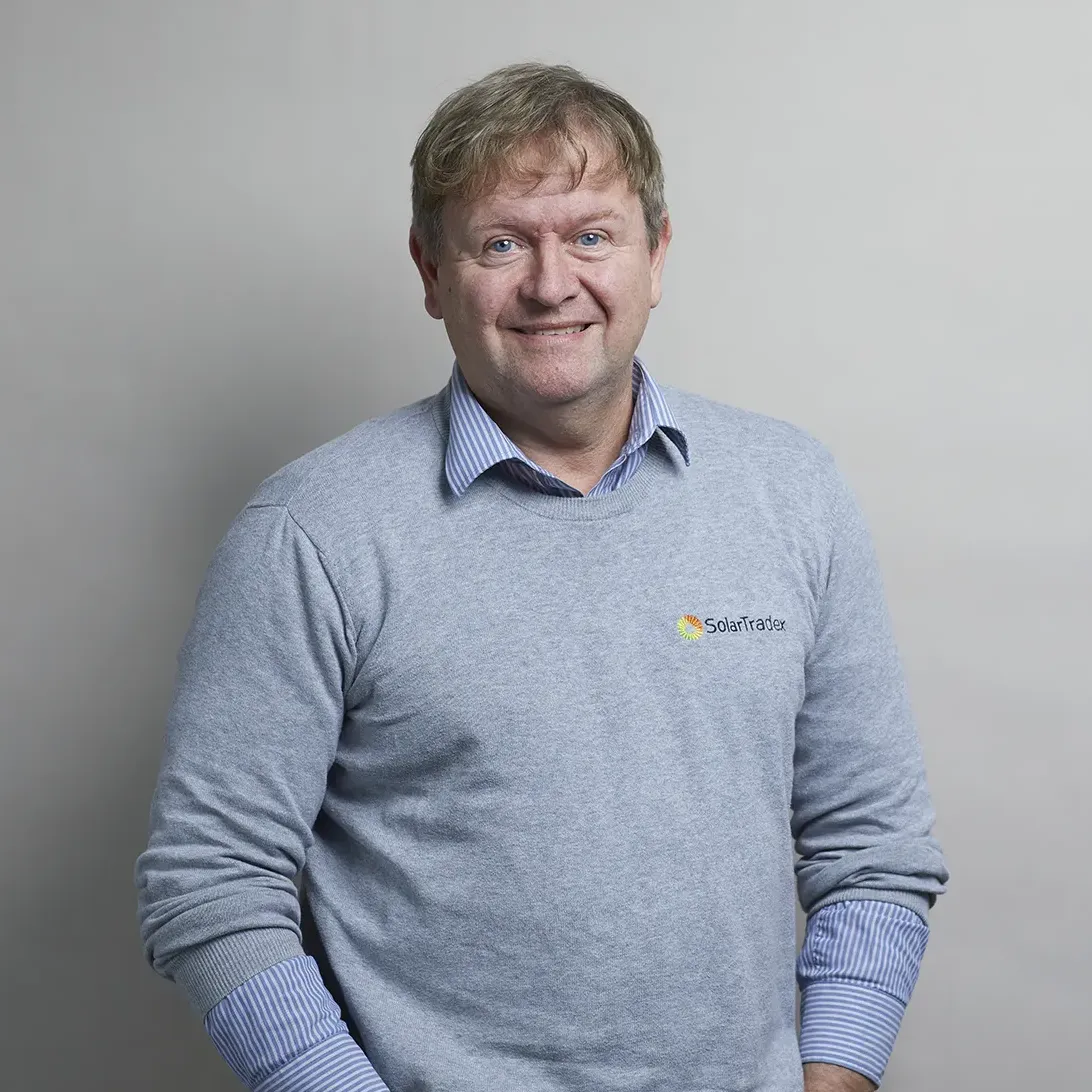Turnkey solar self-consumption
At SolarTradex we are specialists in solar panel projects for self-consumption for the residential and industrial sectors.
We take care of all phases of the project.
1. Design and feasibility study.
2. Supply of materials.
3. Installation and start-up.
4. Processing work permits.
5. Legalisation of the installation.
6. Application and management of tax credits and subsidies.
Engineering and our own team of installers
At SolarTradex we have engineers on staff who are specialists in the design and drafting of solar self-consumption projects for both the residential and industrial sectors.
Likewise, we install all projects with our own teams of installers so that we control and supervise all phases of the project with our own personnel, and in the event of a subsequent incident, we ourselves are in charge of resolving it.
5 year installation warranty
We work with the main worldwide brands in the sector and offer the following guarantees with our facilities.
- Solar panels: Product and production guarantee up to 25 years.
- Solar inverters: Guarantee of up to 10 years.
- Solar structures: 10-year warranty.
- Batteries: Guarantee up to 15 years.
And we offer a 5-year self-installation warranty on all of our residential installations.
We finance your installation for up to 10 years
We have agreements with different financial entities that allow us to finance up to 100% of solar panel installations in the residential sector with financing periods of up to 10 years
For the industrial sector we can also offer different forms of financing and with various financing periods:
- Leasing.
- Renting.
- PPA.
installation of solar panels
Municipal tax credits for IBI and ICIO, deduction in personal income tax (IRPF) and non-refundable "Next Generation" subsidies
Team of professionals
We are committed to offering the best service and working hand in hand with our clients to achieve the most appropriate and efficient solution in each case. With our highly qualified and experienced team, you can be sure that your project will be in good hands.
Frequently asked questions

What is self-consumption and how does it work?

It is the ability of one or more consumers to generate, manage and consume energy in the same location or remotely, whether with or without energy accumulation. Each kWh produced and self-consumed is 1 kWh less that we must buy from the electricity company with its corresponding savings on the electricity bill.
Solar panels generate direct current that is received by the inverter, which transforms it into the alternating current that we consume at home.
We inject the generated solar energy (in most cases) directly into the main electrical panel of the house, so that if at a given time we are generating 3 kWh and consume 4 kWh, then the first 3 kWh of consumption will come from the solar panels we will buy the kWh that remains to complete consumption from the electricity company.
And also the other way around, if at a given hour we are generating 3 kWh, and we are only consuming 2 kWh, then the entire consumption will come from the solar panels and the excess solar kWh will be sent to the grid.
For this kWh that we send to the grid, the electricity company will apply a discount to our electricity bill (compensation).

How does shading from an antenna or railing affect my installation?

The solar panels are joined in chains (or strings) in the same way that inside a solar panel the different solar cells are also joined in 3 or 4 chains which are joined at the top of the panel (currently there there are panels that are joined in the central part).
We can imagine these chains as pipes through which water circulates. If we have a shadow that only affects one cell, it will turn out that it will not circulate (water) through all the cells that are connected in chain within the panel.
And if this panel has 4 chains, then only 75% of the water will reach the top of the panel, and this panel will only pass 75% of the water to the next panel connected in chain and therefore to the end of the chain will only reach 75% of the water and all because of a single cell.
In summary, all shadows are important and therefore it is advisable to minimize them even if they seem small or only affect a part of a single panel.

The competition is offering me more efficient 550W panels and you only install 385W or 415W panels at most. There is a lot of difference!!

In FV as in real life, size is not the most important thing….
The efficiency of a panel is the relationship between power and surface area of the panel, therefore a large 550W panel may be less efficient than a smaller 385W panel if the W/m2 ratio is higher. The panels we work with at SolarTradex have an efficiency between 20.6% and 21.3%, and are within the high efficiency segment.
The more efficient the panel, the more kWp you can install it on a given surface.
If you want much more efficient panels - 1% more - you will have to pay practically double for the panels and it may not be worth it.

How come 10% VAT is applied to my invoice?

The VAT law allows 10% VAT to be applied to renovation and repair works.
A solar photovoltaic installation may be considered a renovation or repair installation if and only if:
- if the recipient of the work is someone who uses the home for private use or a community of homeowners.
- the recipient cannot act as a businessman or professional.
- The construction of the home is completed at least two years in advance.
- The cost of purchasing the materials by the industrialist does not exceed 40% of the final cost of the work.
- For this reason, we always ask for a signed declaration from our clients in order to apply this 10%.
Finally, we can also apply 10% VAT to self-promoters.

Do solar panels hold up if you have a hail storm?

It is a very common question asked by anyone considering installing solar panels at home, and the answer is yes, except in exceptional cases. The most common photovoltaic panels on the market today are manufactured in compliance with specific regulations regarding large impacts to the glass.
The modules are made of tempered glass, thermally processed to obtain greater resistance than conventional glass. They must pass hail impact tests, which according to the IEC 61215 standard must withstand the impacts of these ice balls of different diameters and at different speeds.
Now, we are increasingly experiencing more extreme weather episodes, and this means that it cannot be ensured that if a larger stone falls, or at a greater speed than that of the pots, the panels could break as happened with the summer hailstorm in La Bisbal.
The most advisable thing is to insure the solar installation, beyond the house's own insurance and insure it against these extreme episodes of wind and/or hail.
Often in the case of disasters of this style, the insurance will not cover if there is a declaration of a disaster zone by the Government. In this case it will be the Insurance Compensation Consortium who will take care of them. However, for this to happen it is necessary to have insurance.

Is it possible to disconnect from the company/Endesa/the network?

Possible certainly, intelligent no. If you want to disconnect, you will have to size the installation to guarantee at least 3 days of autonomy, and that means having to make the installation larger and install batteries large enough to store energy for 3 days.
In addition, you will have to install a backup generator set in case, for example, in winter, we have bad weather for a week without being able to charge the batteries.
Obviously this is much more expensive than installing a self-consumption installation with network support.
Furthermore, having an isolated installation means always being aware of consumption and battery charge, and this goes against comfort, since you cannot come home and turn on the air conditioning as and when you want, you cannot bathe in the bathtub with candles, etc… you know what I mean.

On an east-west sloped roof, is it a good option to raise the panels so that they face south and produce more?

At SolarTradex it is a very bad option, for the following reasons:
Esthetic. We need to make PV sexy, and seeing a house with raised panels on a sloping tile roof is just the opposite.
It is dangerous: we are experiencing more and more extreme weather conditions and placing elevated panels on a sloping roof only increases the wind load and plays with fire so that the installation flies away on the day you least expect it.
The Urban Planning Law does not allow it, since the urban planning of the municipality where they are installed would have to be modified. Installation on the roof of buildings and other auxiliary constructions, including car park pergolas, is only permitted when the installations do not exceed one meter in height from the flat roof or, in the case of a sloping roof, when the collectors or panels are located attached in parallel.
If we want to maximise solar generation, today it is much more profitable and safe to install a couple more solar panels in a coplanar arrangement facing east or west, since the price of solar panels has dropped very significantly and the cost of the structure It will also be cheaper.

Can we place modules facing north?

Orienting the modules to the north will always be the last option, but if it is not possible to orient the modules to the south because we do not have space, or because we need to put more power to cover consumption and we do not have east-west options, then we will orient the panels to the north. without any problem.
It must be taken into account that panels facing north in Catalonia produce approximately 10% less than modules facing south to Germany.

What are virtual batteries? How do they work?

Virtual batteries are a mechanism by which energy retailers keep your surplus and compensate you for the full price of the energy that remains in future bills without price limitations and even allow the surplus to be assigned to different locations.
A priori it seems like a very good idea, since you can value the excess kWh at the same price as if you stored them in a physical battery but without having to make the investment.
However, if the rate of solar installations continues to grow in the current way, in the end the price of energy in solar time will fall so much that it will be impossible for marketers to allow you to compensate for these surpluses with energy consumed in expensive hours (night).
Therefore, it is a good possibility in the short term, but in the medium-long term, the future of accumulation will surely go through physical batteries.

Does it make sense to install a larger inverter in case I want to expand my installation in the future?

It makes sense if you are clear that in the future you are going to consume more, but again we must remember what we said in the previous point; Adding 4 more panels in the future will always cost significantly more than if you install them now.

What is the useful life of an installation and what guarantees do you offer?

A solar installation currently has a proven life of more than 25 years. Consider that a solar installation does not have moving mechanical parts that suffer wear, or circulating fluids that cause overpressures as occurs with solar thermal energy. Therefore, if the installation has been well designed, it is very reasonable that the useful life should be greater than 25 years.
The modules degrade over time and lose production capacity, however manufacturers give a minimum production guarantee of 80% after 25 years; That is to say, they assure that after 25 years, the solar panels will produce at least 80% of what they produce on the first day.
Additionally, the panels have a product warranty of at least 12 years against manufacturing defects.
Current inverters have a useful life of more than 15 years and the inverters we offer have a 10-year warranty.
Battery: the most common batteries for solar installations are lithium iron phosphate (LiFePO4) and usually have a 10-year warranty and a useful life of more than 6,000 cycles (16 years).
The structures we offer generally have a 10-year warranty.
In addition, we as an installation company offer a 5-year installation warranty, far beyond the 2 years required by law that most installation companies offer.

Are there alternatives to installing batteries if I don't want to spend so much money?

There are other storage systems to store surpluses. We have surplus diverters (Fronius and Lacecal for example), which when they detect that solar generation is lower than consumption, they divert the surplus to an electrical resistance located inside a hot water tank, so that the water is preheated. coming from the street before reaching the boiler/water heater and thus the thermal jump necessary to heat it is reduced.
Batteries store energy in the form of chemical energy and DHW accumulators in the form of thermal energy.
Another solution for those who have an electric car and a possible charging point is to install an electric vehicle charger (EVC) that allows them to take advantage of solar surpluses.

Is it advisable to install a battery?

If we install a battery we reach the maximum value for each kWh generated, since we value all the kWh generated at the price we buy electricity at home. To achieve this maximum value, it is necessary to invest in the battery, which generally represents an extra cost of between 60% and 70% compared to the installation without a battery.
On the contrary, if we do not install the battery, the surpluses that would go to the battery will be sent to the electrical grid and will be compensated/valued at a lower price than if we had saved them. The advantage of not installing the battery is that you save that 60% - 70% extra cost.
If we think about buying a battery in economic terms, the amortization of the installation may be longer, but in any case the economic factor is not always decisive, since there are many people who buy batteries from us because they want to achieve maximum autonomy with respect to the electricity company. .
Furthermore, we must not forget that as more solar systems are installed, the price of electricity during the day will fall and at night it will be more expensive, and therefore it will be more profitable to install batteries.

How does surplus compensation work?

In those self-consumption facilities with less than 100 kW of power and that are connected to the internal network of any of the consumers associated with the generation facility, the electricity company will value the surpluses (leftovers) that we send to the distribution network in accordance which is called simplified compensation mechanism.
Of the energy produced by the photovoltaic installation, the energy that cannot be self-consumed at the moment (solar surplus) will go to the electrical grid and the bidirectional meter of the marketing company will count hourly the total energy sent (exported) into the grid. of distribution.
Each electricity distribution company values the kWh sent to the network at a different price, adding their value during the month.
At the end of the month, when we receive the invoice, we will see a discount line with the total economic value of the kWh sent to the grid.
The electricity bill can never be negative, and therefore if the installation has many surpluses, a part of these may not be able to be valued and may be lost.
It is important to keep in mind that the value they give us for the surplus is always lower than the value we pay for the electricity consumed, and therefore we will always have maximum profitability and lower payback with installations with little surplus.
However, if we try to make an installation without surpluses, the resulting installation may be very small, and therefore the savings in absolute value will also be lower.
Therefore, the most appropriate thing is always to achieve an optimal balance between profitability (small installation with little surplus) and savings (larger installation with more surplus) that satisfies the client's needs, each client is different.

The competition offers me microinverters and tells me that the production will be much higher.

Performing an installation with microinverters can be a very good option if you have significant shadows in your installation.
Working with microinverters allows the shadows on some panels not to affect the rest of the panels; however, if you don't have shades you will pay a premium for the installation and the installation will work just as well as without microinverters.
If you install microinverters and a microinverter breaks down, you will not lose the totality of the production compared to installing a single inverter, but on the contrary you will have much more chances of an inverter breaking down than if you work with a single inverter.
In addition, if a microinverter is damaged, you will have to climb up to the roof to repair it and remove the corresponding panel, so the cost of repair/replacement will be much higher.








